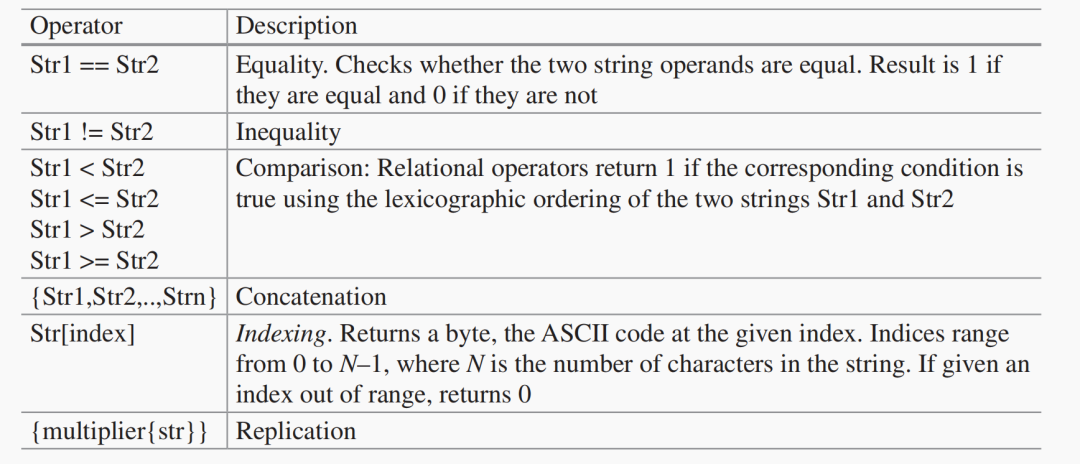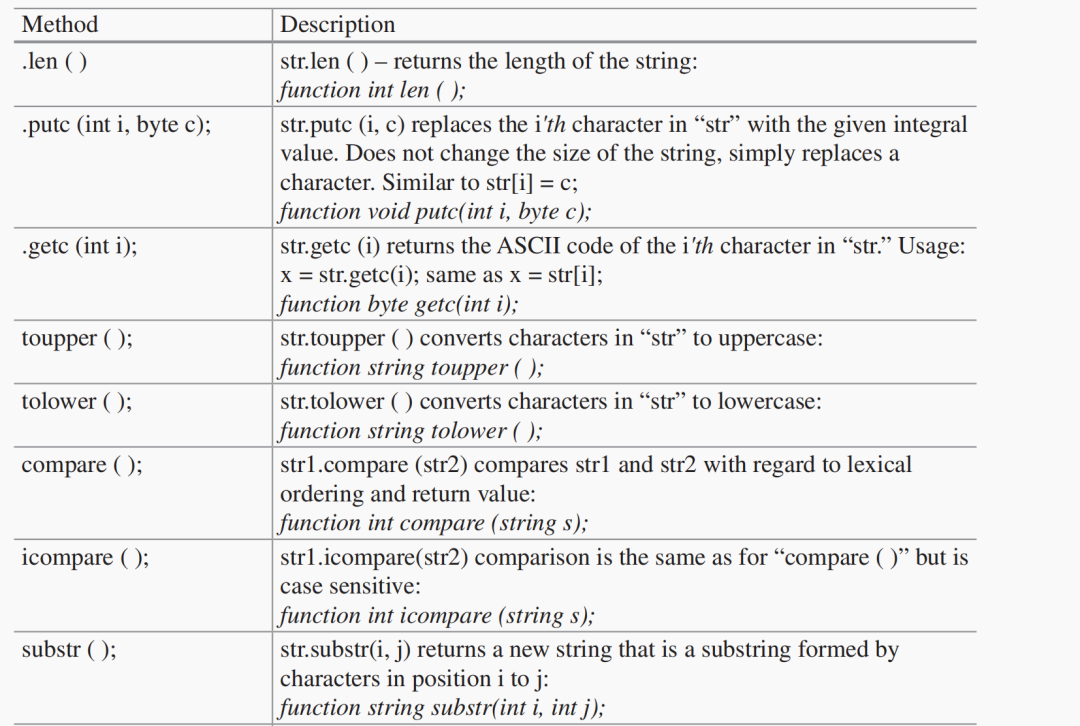

关于字符串数据类型的示例
描述
字符串数据类型是一个有序的字符集合。
字符串变量的长度是集合中的字符数。
字符串类型的变量是动态的,因为它们的长度在仿真过程中可能会变化。
字符串中的单个字符变量的类型为byte。
Syntax:
string variable_name [= initial_value];
如果在声明中未指定初始值,则将变量初始化为" ",一个空字符串。空字符串的长度为零。下面是一个字符串数据类型的示例:
module datatype1;
string s1 = "hello";
string s2 = "hello world";
string s3 = "helloworld"; // is ignored
string s4, s5, s6;
initial
begin
s4 = "later";
s5 = ""; //empty string
s6 = {"hi", s5}; //concatenation
#10;
$display ("s1=%s s2=%s s3=%s s4=%s s5=%s s6=%s", s1, s2,
s3, s4, s5, s6);
#100 $fnish;
end
endmodule
在本例中,我们声明了6个字符串,从s1到s6。s1、s2和s3分别进行了初始化。其中字符串s3中的转义字符()被转义为空字符。
然后在“initial”语句块中,将s4赋值为字符串“later”,将s5赋值为空字符串,并连接s5与" hi ",赋值给字符串s6。下面是仿真log:
ncsim> run s1=hello s2=hello world s3=helloworld s4=later s5= s6=hi
String Operators
字符串数据类型还提供了处理字符串的操作符,如下表所示:

module datatype1;
string s2 = "hello world";
string s3 = "helloworld";
string s4, s5;
string s6 = "compare";
string s7 = "compare";
string s8;
integer s2len, s3len, s2c;
initial begin
#10; $display ("s2=%s s3=%s",s2,s3);
#100 $fnish;
end
initial begin
#15;
s2len = s2.len( ); $display("String Length s2 =
%0d",s2len);
s3len = s3.len( ); $display("String Length s3 =
%0d",s3len);
if (s2 == s3) $display("s2 = s3"); else $display("s2
!= s3");
if (s6 == s7) $display("s6 = s7"); else $display("s6
!= s7");
s4 = s2.substr(1,6);
$display("s4 = %s",s4);
s5 = "later ";
s8 = {3{s5}};
$display("s8 = %s",s8);
S2c = s2[0];
$display("s2c = %s",s2c);
end
endmodule
在上面的例子中,声明了字符串s2到s8并初始化为各种字符串。
将字符串长度(.len())赋值给整数类型s2len和s3len。
比较字符串s2和s3以及字符串s6和
s7。
提取s2的部分字符串并将其赋值给s4。
复制s5三次,赋值给s8。
下面是仿真的log:
s2=hello world s3=helloworld String Length s2 = 11 String Length s3 = 10 s2 != s3 s6 = s7 s4 = ello w s8 = later later later s2c = h $fnish at simulation time 110 V C S S i m u l a t i o n R e p o r t
String Methods
还有几种方法可用于处理字符串,如下表所示:

module sMethods;
string s1 = "hello";
string s2 = "hello world";
string s4;
string s5 = "GOODBYE";
byte x;
integer s2len, s3len, i1, i2;
initial
begin
#15;
s2len = s2.len( );
$display("String Length s2 = %0d",s2len);
s1.putc(0,"C"); //replace 0'th character with 'C'
$display("String s1 = %s",s1);
x = s1.getc(0); //get 0'th character of string s1.
$display("0'th character of string 'Cello' = %s",x);
s4 = s2.toupper( ); //convert string 's2' to upper case
$display("Upper Case of 'hello world' = %s",s4);
s4 = s5.tolower ( );
$display("Lower case of 'GOODBYE' = %s",s4);
end
endmodule
以及仿真log:
String Length s2 = 11 String s1 = Cello 0'th character of string 'Cello' = C Upper Case of 'hello world' = HELLO WORLD Lower case of 'GOODBYE' = goodbye V C S S i m u l a t i o n R e p o r t
在上面的例子中,
声明一些字符串变量。在“initial”语句块中,我们首先得到字符串(s2 = " hello world ";)的长度11。
然后使用" putc "方法给字符串" s1 "的第0个字符加上字符" C ":
s1.putc(0,“C”);
由于s1字符串是“hello”,它现在变成“Cello”。然后,得到字符串s1的第0个字符(现在是“Cello”):
x = s1.getc (0);
我们使用.toupper方法将" s2 "字符串(s2 = " hello world ")转换为全大写,并将结果存储在字符串" s4 "中:
s4 = s2.toupper ();
将" s5 "字符串(s5 = " GOODBYE ")转换为全小写(.tolower方法)
s4 = s5.tolower ( );
审核编辑:汤梓红
-
SQL 通用数据类型2025-08-18 611
-
字符串在数据库中的存储方式2025-01-07 1311
-
鸿蒙原生应用元服务开发-仓颉基础数据类型字符串类型2024-09-18 350
-
labview字符串的四种表示各有什么特点2024-09-04 1918
-
labview扫描字符串怎么用2023-12-29 3735
-
Redis数据类型介绍2023-10-09 1258
-
字符串的相关知识2023-03-29 1719
-
什么是字符串2023-02-23 9098
-
Python-字符串2023-02-16 2082
-
Python字符串的数据类型与拼接2022-08-16 2037
-
C语言_字符串与指针的练习2022-08-14 2203
-
2.2 python字符串类型2022-02-17 1898
-
c#数据类型转换-数值字符串和数值之间的转换2017-11-14 3848
-
字符串的表示2009-10-13 3475
全部0条评论

快来发表一下你的评论吧 !

